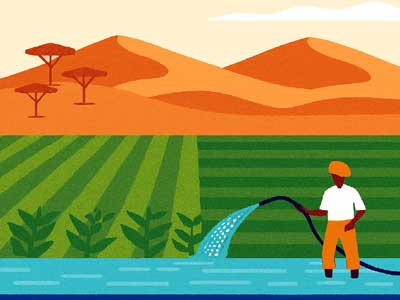The Indira Gandhi Canal Project and improved water management have played a crucial role in halting the expansion of the Rajasthan desert and promoting greenery.
By bringing water to the Thar Desert, the project has expanded cultivable land, encouraged afforestation, and improved local rainfall patterns. Earlier, there was concern that the desert might extend toward the Braj region, but the canal helped control soil erosion, raised groundwater levels, and stabilised the local ecology. Today, many areas of Rajasthan exhibit lush greenery — a testimony to how sound water policies and sustainable management can reverse desertification. The project has not only been a boon for farmers but has also slowed the pace of regional climate change.
Read in Hindi: बेहतर जल प्रबंधन से थमा रेगिस्तान का बढ़ाव
In the 1970s, environmentalists and planners had warned that if timely action wasn’t taken, Rajasthan’s Thar Desert would gradually creep into Haryana, Delhi, and western Uttar Pradesh — especially toward the Agra division, Braj region, and even Govardhan. Now, five decades later, there is some relief: satellite data and environmental experts confirm that the desert’s expansion toward the northeast has significantly slowed down.
This transformation didn’t happen overnight. It is the result of long-term planning, public participation, and dedicated efforts — particularly the Indira Gandhi Canal Project, which stretches nearly 700 kilometres and has become a lifeline for western Rajasthan, transforming its arid lands into cultivable green zones.
The canal has provided water to districts like Sri Ganganagar, Bikaner, and Hanumangarh, increasing agricultural potential, rejuvenating vegetation, and pushing back the march of the Thar. Dust storms have become less frequent, and soil erosion has been curbed. There has also been a modest rise in groundwater levels and rainfall.
The preservation and plantation of native tree species such as khejri, ker, and babul — along with public campaigns like Van Mahotsav — have played an important role in ecological stability. Water conservation methods like rooftop rainwater harvesting, restoration of water tanks, and drip irrigation have also helped slow desertification.
Though the desert's pace has slowed, experts warn that the danger isn’t entirely gone — only its direction has changed. The threat to Braj today arises less from the Thar and more from local negligence.
Rapid urbanisation, reckless deforestation, disregard for traditional water bodies, and unregulated groundwater extraction are seriously harming the ecology of Agra, Mathura, and Govardhan. The degraded condition of the Yamuna River and the disappearance of centuries-old sacred groves, i.e. kunj-vans, are also signs of environmental decline.
Environmental expert Dr Debashish Bhattacharya emphasises that if the Braj region is to avoid becoming semi-arid in the future, strong measures must be implemented now. He advocates for the restoration of ponds, stepwells, and canals, the development of green belts, and the prioritisation of the rejuvenation of the Yamuna. Environmental education in rural areas and designated green zones in urban master plans is the need of the hour.
Yes, it is true — the desert’s expansion has paused, and that’s a significant achievement. But it is a temporary truce, not a permanent solution. If climate change, unbalanced development, and weak local planning continue, the Thar may not have to spread — we ourselves may create desert-like conditions.
It is now time for a renewed commitment to greenery and water conservation — from policies to individual behaviour. Only then can the land of Braj be saved, and the approaching footsteps of the desert be silenced for good.

















Related Items
Enduring relevance of Mahatma Gandhi's ideology
Dal Lake shines with Khelo India Water Sports Festival
Rahul Gandhi's Speech: Political One-upmanship or a Diplomatic Blunder?